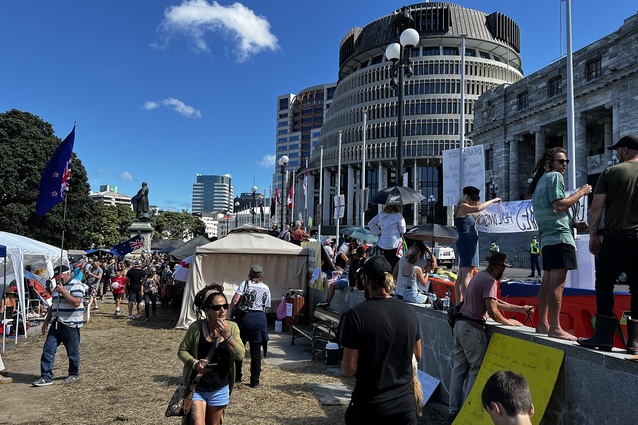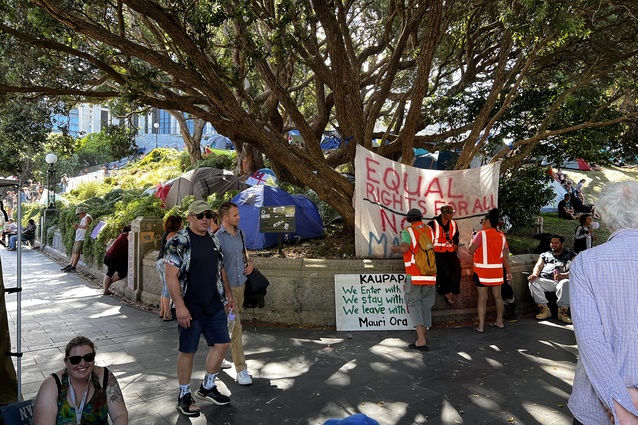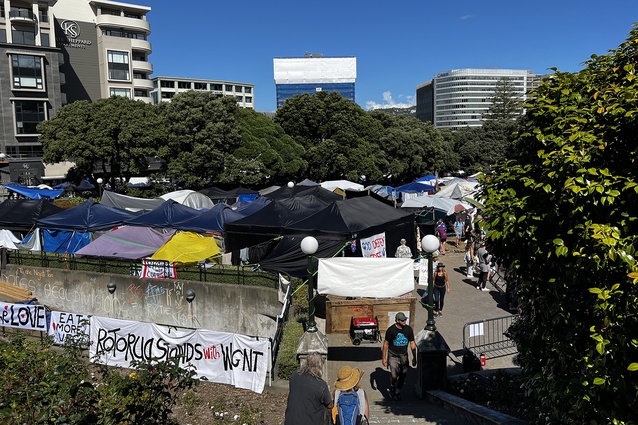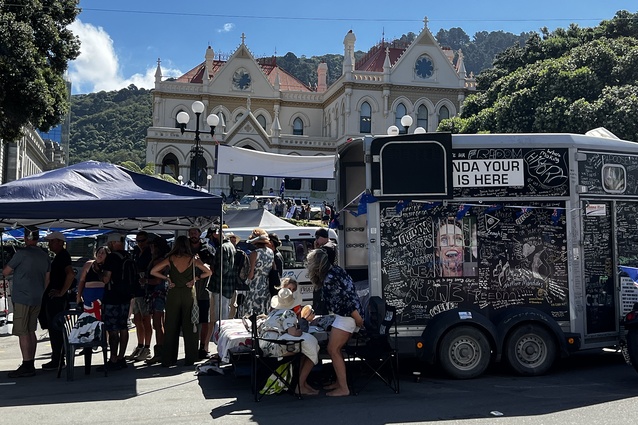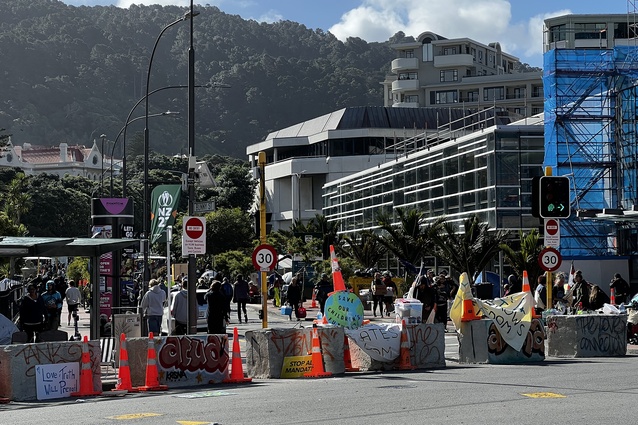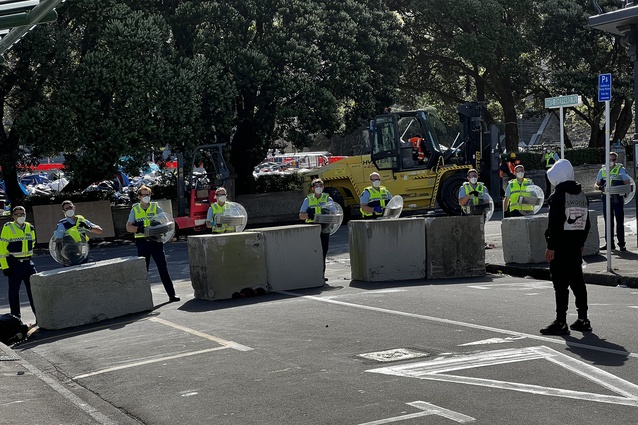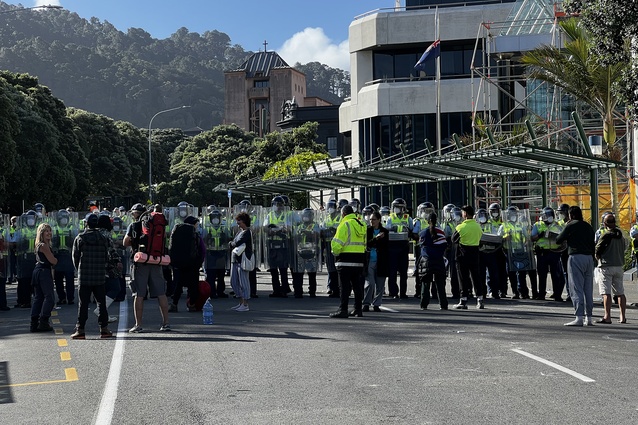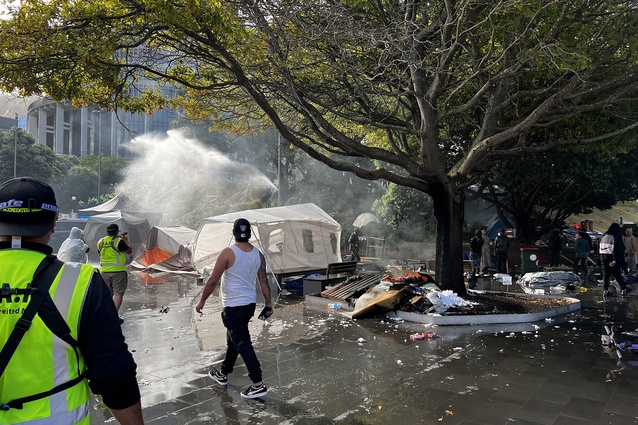Editorial: Deploy the fence
They drove. They parked. They camped. Initially, life in the tent village beside Wellington’s ‘Beehive’ parliament building seemed spontaneous and carefree. They didn’t seem to mind being soaked by the parliamentary lawn sprinklers or being blasted by Barry Manilow’s greatest hits, courtesy of the Speaker of the House. They had food, toilets and a hairdresser’s tent.
Except for the straight line of plastic traffic barriers separating the encampment from the front of the old and newer parliament buildings, there were no boundaries. Unimpeded, they expanded into the surrounding streets. Then, on day 14, the fences went up. Technically, they were concrete barriers: big rectangular blocks of concrete, forklifted into place. But really the police were fencing them in.
As Richard Francis-Jones writes in his excellent Truth and Lies in Architecture (see review) “A shortening from the term defence, ‘fens’ is the fourteenth century origin of the word fence. The fence is a distillation of the wall. Perhaps an effective restraint to animal life, but as actual physical protection to natural and human hostilities it is weak and next to useless. Its power is not physical at all; it is symbolic and representational; it is a marker of an invisible force. Fences represent boundaries that will be enforced.”
These inert sentinels of power set new boundaries, now blocking access to Hill Street, the rear end of Parliament on Ballantrae Place, Molesworth Street near Pipitea Street, Murphy Street and Aitken Street, Kate Sheppard Place, Bunny Street near the railway station, the corner of Whitmore Street and Lambton Quay and the bottom of Bowen Street, and at the intersection of Lambton Quay and Mulgrave Street.
Over the next few days, the police began moving the blocks inwards. On day 15, the bollard line on Aitken Street and Hill Street was moved in about 50 metres, and about 100 metres on Molesworth Street.
There was some pushback. On the evening of day 16, some of the campers managed to heave some blocks out of position, enough to let about 20 cars back into the encampment. The next day, police forklifted in more blocks to remedy the breach.
Around this time, quite a lot of campers left. On the 17th day, the site was named by the Ministry of Health as a location of interest. Some of the campers were clearly getting Covid although some remained convinced it was the electromagnetic field (EMF) weaponry “devices” being unleashed upon them. Some donned head masks – tinfoil hats. About this time, you could be forgiven for thinking the social contract really had gone out the window. Many of the campers seemed to have joined the sovereign citizen movement, whose adherents insist they are above the law. “In other words, they arrogate to themselves sovereign powers that not even the monarch enjoys,” as George Monbiot put it in The Guardian, adding that such “incoherent protest movements tend to be infested with racism and white supremacy.” Not to mention rampant conspiracy.
But it was surprising that, instead of moving in with brute force, the police chose to deploy the fence. Was it an act of kindness? Francis-Jones in Truth and Lies argues: “The fencing of land was a quick, economical and efficient instrument of private ownership, power and the associated exclusion.” Here, the fence was almost like an act of inclusion, its perimeter encircling a tract of public land given to, temporarily owned by, them – the campers.
By the 19th day, more cars arrived and tried to enter but the line between inside and outside held – the police holding the outside and the outsiders defiantly holding the inside. As Francis-Jones explains: “The fence has been a remarkable instrument of occupation, control and suspect claims of ownership.”
It messed with your head. Fenced in, in the middle of downtown Wellington public space was the collision of campers, determined, no matter how wacky many of their ideas, to be heard. What was on show, even if it was a minority Aotearoa view, was something uneasy, something not well at the edges of the team of five million.
It’s not a huge leap to compare this with the Occupy movement begun in October 2011, when thousands of people here and in other cities around the world started to occupy public spaces – to promote a pro-democracy, civil liberty, social justice message and to protest against corporate greed and economic inequality.
In Truth and Lies, Francis-Jones argues that occupation was an attempt to reclaim our public space from governmental and corporate dominance and that we need to find an authentic public space. “An inclusive space of civic liberty, tolerance and acceptance, an urban space of ‘public appearance’ that is not owned by state or private interest, but to which we all hold shared responsibility and custodian-ship.”
Isn’t authentic public space exactly what’s on show in the Wellington encampment? As Francis-Jones describes it, such a public space within our city “would be open and organic in character, able to respond to the pressing needs and issues of the moment”. Such as fencing off a portion but still allowing protest – a space of political freedom arising from the actions of citizens, even if some of them seem barmy.
Which leaves just one question. When the campers have gone (as I write, they are still there), should the concrete-block fence, or at least some of it, remain? A monument perhaps to the worthy cost of inclusive public space in our capital city.

